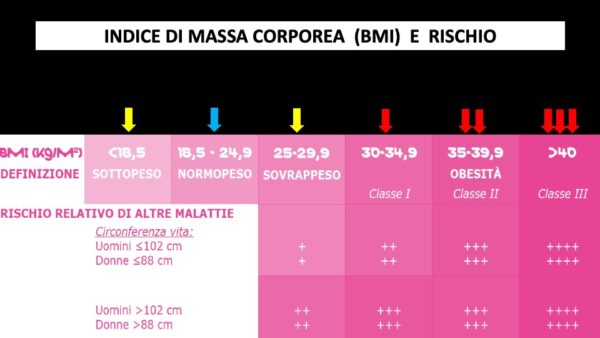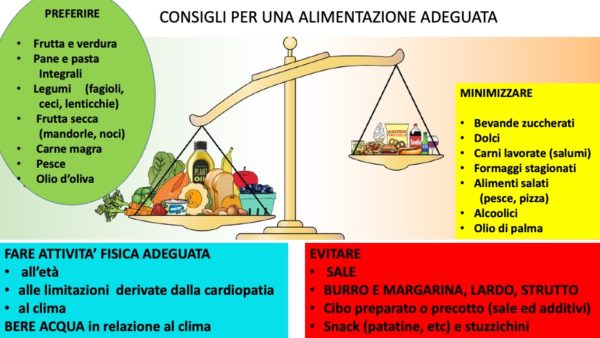di Laura D'Ettole
Proper nutrition allows you to contain the symptoms often complained of by patients with cardiomyopathy and lead a peaceful life. The scientific world has long agreed on the great potential of proper nutrition and its beneficial influence on health, but what are the rules to follow for a patient suffering from cardiomyopathy? These guidelines are taken from the latest version published in America.
Let's start with the body mass index (BMI). You have to look in the mirror and take some measurements. This indicator consists of a simple calculation that each of us can do, (https://www.salute.gov.it/portale/nutrizione) just divide your weight by your height squared. The number you get is precisely the BMI. In the table we can see the results of this simple operation. An index contained in the interval between 18,5 and 24,9 tells us that we are of normal weight, in good physical shape and that we have a low risk factor relating to various pathologies. But it doesn't end there, because we must also monitor our body lines and measure in particular everyone's weak point, the waist circumference, where fats accumulate that increase the risk of cardiovascular disease and stroke.

For a woman, the established waistline (measured just above the navel) must not exceed 88 cm, for a man 102. Both of these values (BMI and waist circumference) allow for "self-diagnosis" and tell us what to do, i.e. if continue with what has been done so far, adjusting some things, or run for cover immediately to restore acceptable parameters perhaps with the help of a nutritionist.
Before moving on to the recommended diet, it is also necessary to dwell on one's lifestyle: active or excessively lazy? It is absolutely necessary to continuously carry out physical activity measured according to your age and the limitations deriving from heart disease, as recommended by your doctor. And it is very important to hydrate the body, i.e. drink water according to climatic variations. Obviously, when the temperature rises, you have to drink more and more. Water eliminates toxins, purifies the body, but also helps blood pressure and breathing. Carrying a bottle of water with you during the day is a good habit that many people now follow.
Now we come to the actual diet. The food purchase phase is an essential starting point because awareness of the importance of food selection and choice is concentrated here. In the supermarket, cross and delight of every consumer, there are departments in which to linger for a long time and others to be decidedly avoided. First of all, it is necessary to establish the "weight" to be attributed to the three main meals. First prescription: prefer breakfast and lunch and "lighten" dinner as much as possible. If you feel the need for a light snack in the middle of the day, absolutely avoid snacks, snacks, chips and stuff like that.
The foods to preferably include in the diet, as indicated in the table, are: bread and pasta, fruit and vegetables, legumes, lean meat, fish, olive oil (to be used sparingly), and also dried fruit. Eliminate: butter, margarine, lard, pre-cooked or prepared foods, salt. Minimize: sugary drinks, alcoholic beverages, sweets, cured meats, aged cheeses, salty foods (including pizza), palm oil.
Here is now, broadly speaking, the composition of a correct diet for the patient suffering from cardiomyopathy. Bread and pasta are foods that must be preferred by young people and adults with intense physical activity. These same foods, on the contrary, must be reduced or abolished by those who have a much less active lifestyle, as well as by overweight or obese individuals. It is also necessary to eat vegetable and legume soups regularly. And what about extra virgin olive oil and wine, so typical of the Mediterranean diet? Not to abolish them, but they must be used with absolute moderation.

